


 2013年沙特杰纳第利亚遗产文化节中国主宾国开幕
2013年沙特杰纳第利亚遗产文化节中国主宾国开幕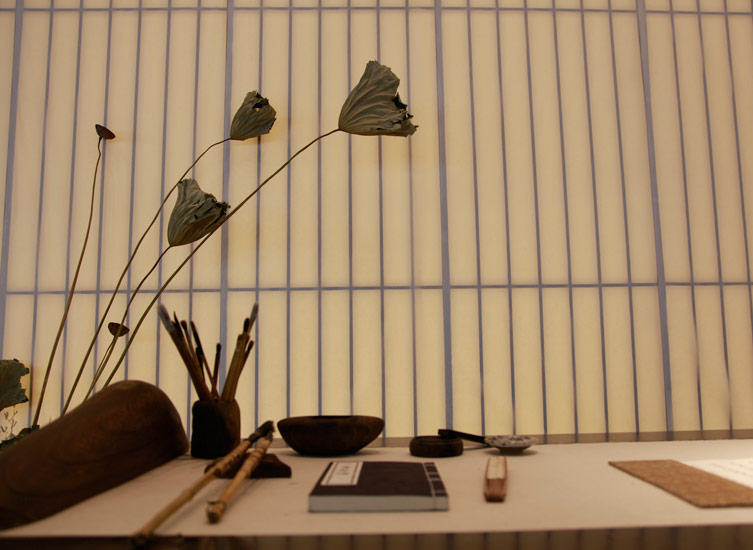 2013年沙特杰纳第利亚遗产文化节中国主宾国开幕
2013年沙特杰纳第利亚遗产文化节中国主宾国开幕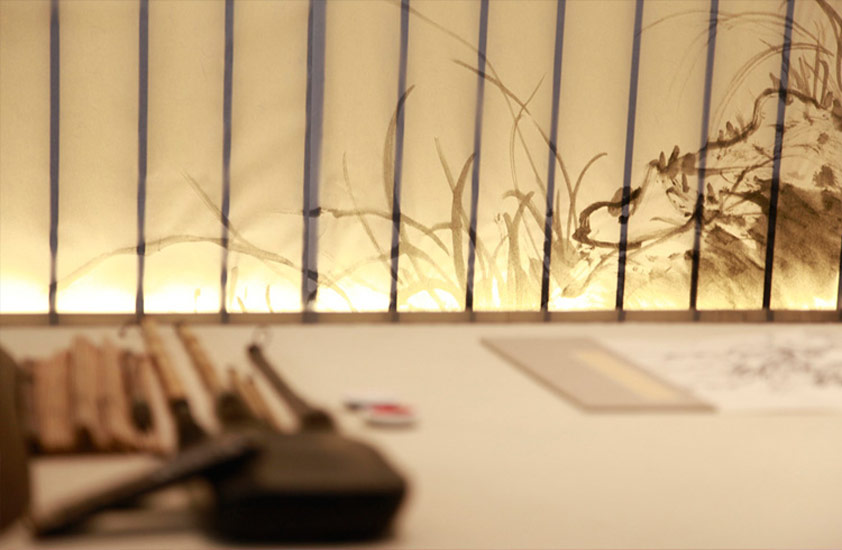 2013年沙特杰纳第利亚遗产文化节中国主宾国开幕
2013年沙特杰纳第利亚遗产文化节中国主宾国开幕 展区全景
展区全景 开幕式
开幕式 王鹏先生布展
王鹏先生布展 现场
现场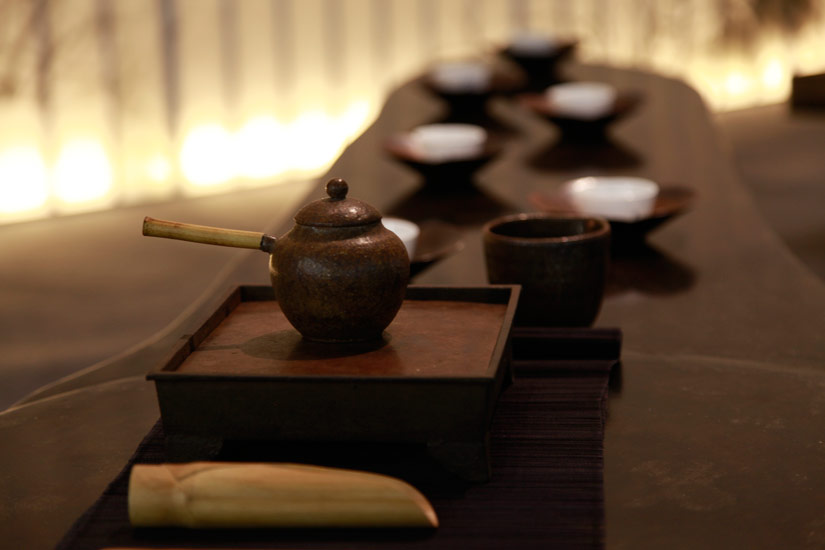 茶道
茶道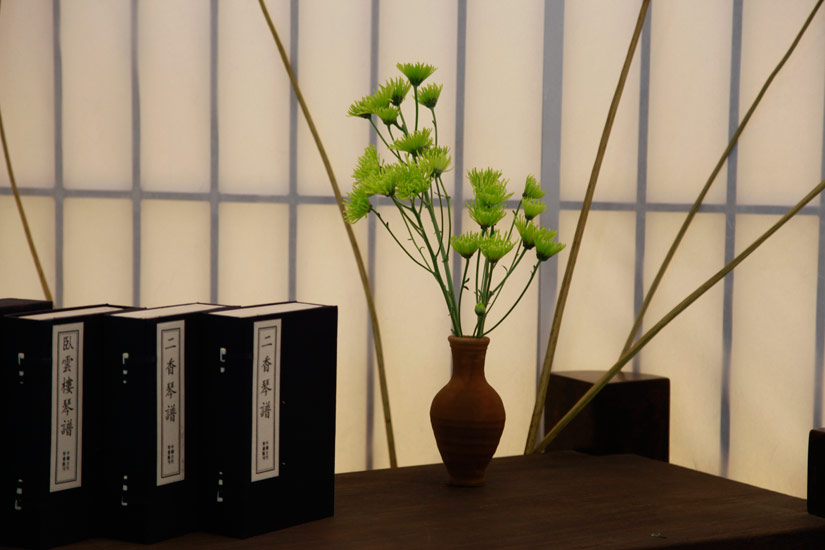 花道
花道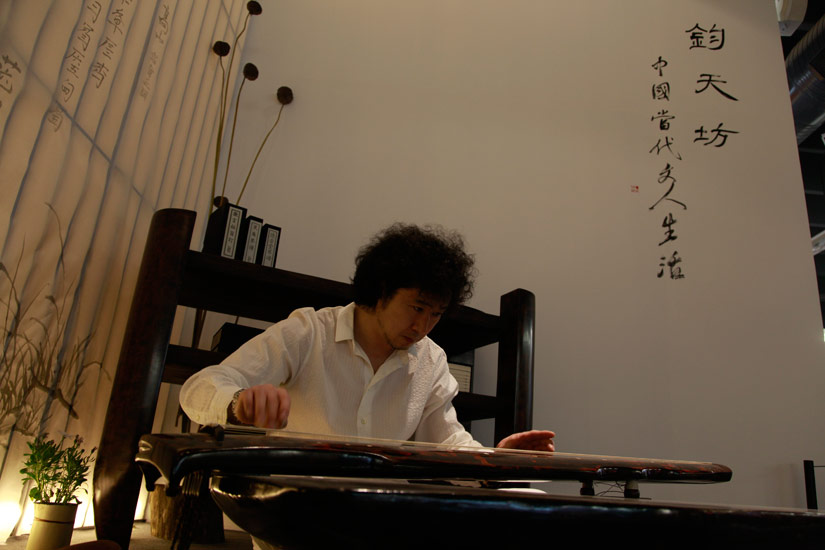 金鹏先生演奏
金鹏先生演奏
由文化部联合国家宗教事务局、北京市人民政府、江西省人民政府、甘肃省人民政府、中国驻沙特大使馆共同主办的2013年沙特杰纳第利亚遗产文化节中国主宾国活动,于4月3日在沙特首都利雅得正式拉开帷幕。沙特国民卫队司令、杰纳第利亚遗产文化节主席米特阿布亲王,与中国文化部部长蔡武、中国驻沙特大使李成文受邀出席开幕式,并携手为中国南狮开光点睛,揭开为期17天的中国主宾国活动的序幕。
作为一年一度海湾地区乃至阿拉伯世界最重要的艺术节之一,沙特杰纳第利亚遗产文化节今年特意邀请中国担任主宾国,活动以“璀璨中华”为主题,提出“文明,与世界分享”的活动主旨,通过中国馆展示、“中国风”户外演出等内容,向沙特及阿拉伯世界全方位展示中华传统文化与现代风貌。中国将有近200人、15个机构、30余项技艺、600余件展品赴沙特参加活动。参展机构及个人均是主办方精心挑选推荐的能代表一方文化的艺术精品、民族遗产。在面积近2000平方米的主宾国场馆内,设置了文明的创造、文明的分享、文明的交融三大板块,以与民众生活息息相关的“衣、食、住、行”为核心主线,设计了“锦绣人间”、“品味醇美”、“文明天下”、“跨越世纪”四个篇章。
此次由钧天坊王鹏老师带队的参展团,将以“中华五道”——琴、书、茶、花、香的综合形式为我们展现中国当代文人生活场景,将中华璀璨的文化有机而立体地呈现出来,为我们带来文化传承的新思路和灵感,并将深厚的中华文明与更多人分享。
其他的参展项目更是琳琅满目。从中国各类丝织技艺的巧夺天工,到高级定制成衣“华服”系列的唯美时尚,从高4米需要两人共同工作的云锦织机,到妙不可言的湘绣“双面绣”,从坚守家族传承600年历史的清真宴席代表“厨子舍”,到景德镇瓷器瓷乐,再到首都博物馆提供的文物精品,丰富多彩的展出内容让沙特民众看到一个既有传统文化传承,又有现代发展创新的活力中国。
米特阿布亲王在接受沙特国家电视台采访时说:“中国文化博大精深,希望这个展览能使更多沙特人了解这个古老和现代并存的文明古国。"
琴道
“琴”是中国历史最为悠久的古乐器之一,至今已经有三千多年的历史,古琴在几千年的传承与发展中,不仅创造并完善了独特的琴器、琴曲、琴谱等,更因其深沉高雅的音色品质与丰富的艺术表现力,成为中华民族精神及传统音乐文化的代表,故历来有“琴道”或“琴学”之称。
琴所蕴涵的文化意义在这里已经超越了乐器本身,不仅能够正心、修身,而且具有齐家、治国、平天下的社会功能,这些都需要琴的中正之音。琴在不觉中已经成为人们日常生活方式的行为准则,“琴文化”也自然成为最具中华民族文化精神的代表。
The Way of Guqin
Guqin is one of the oldest Chinese musical instruments with a history of over three thous years. Through this ancient inheritance development, unique instruments, music compositions scores have been d developed over time. With its deep elegant tone quality nuanced artistic expressive force, Guqin has become a symbol of Chinese national spirit traditional musical culture, hence the term “The Principle of Guqin” “The Studies of Guqin.”
During the long process of development from “Guqin instrument” to “Guqin art” then to more formalized “Guqin Studies,” Guqin has become an integral part of mainstream Chinese culture. The series of “Guqin (Zither), Qi (Chess), Shu (Calligraphy), Hua (Painting), Shi (Poetry), Xiang (Incense), Cha (Tea) Hua (Flower Arrangement)” has been widely recognized by every generation as the best representation of traditional Chinese culture. Chinese scholars’ emphasis on these cultural elements in fact reflects the delights, attitudes life styles they pursued. Guqin always leads this list due to its profound culture history connotations.
Guqin’s cultural significance goes beyond the instrument itself: Guqin, with its pure timbre, is not only helpful in purifying one’s heart cultivating one’s moral character, but also has such social functions as family regulation, state ruling universal harmony. Guqin has become a code of conduct in people’s daily lives, has naturally become the best symbol for Chinese national cultural spirit. No wonder Guqin playing has developed from being mere skills to an actual spiritual practice.
书道
中国的“书法”一词涵义极深,真正的书法是以汉字为基础,用毛笔书写的,其间包含着作者抒情、写意,在不同形式中融入有个性审美意念的一种强调主体精神的艺术。它反映人为主体的精神、气质、学识与修养。它的基点是审美而不是实用;它的表现形态是包含着情、境、意、趣等丰富内容的凝炼抽象形式,而不是整齐、均匀、划一等具有实用工艺美的模式。
而中国画则以书法为基础,同样用最简单的线条结构来表示宇宙万物的变化节奏,以达到“气韵生动”的境界。在他们笔下的自然形象,充满了对人的理解和关注,而人的情感又化作自然的形象得以展现。书画家的情感与人格跟客观的自然景象相互映发,交融在一起。这时的书画作品不仅构成艺术的意境,更体现了“时代的生命情调与文化精神”。
The Way of Calligraphy
Just like other traditional arts such as Guqin Qi (Chess), calligraphy painting in ancient times also revealed the inner world of Chinese scholars. However, they differ from other artistic forms in that calligraphy painting express the creators’ feelings emotions through visual elements of line paint.
The word “calligraphy” in China carries profound meanings. Authentic calligraphy is based on Chinese characters written with brush; it is an art that expresses the author’s emotions thoughts infuses personal aesthetic ideals into visible forms. Calligraphy reflects the calligraphers’ mentality, temperament, learning self-cultivation. It is aesthetic instead of practical, its condensed abstract expressive form is rich in passions, scenes, meanings interests beyond mere pragmatic technical beauty. Therefore, “calligraphy” is strictly distinct from “font” “h writing.”
Chinese painting is based on calligraphy shows with simplest lines changing rhythms cosmic vitality. Qing
